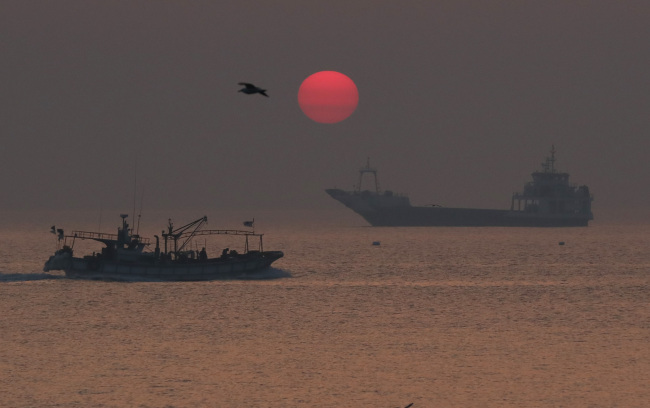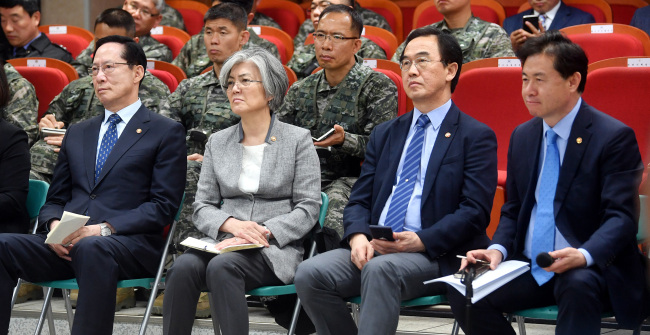Will NK recognize NLL after decades of opposition?
Inter-Korean detente boosts hopes for breakthrough in settling maritime disputes between the two Koreas
By Yeo Jun-sukPublished : May 7, 2018 - 16:13
Just about a month after the armistice agreement was signed in July 1953, the US-led United Nations Command declared the Northern Limit Line on the West Sea to prevent accidental skirmishes between the two Koreas.
However, North Korea has refused to endorse what South Korea and the UN Command have claimed as a de facto maritime border, resulting in a series of cross-border clashes such as naval battles near the border island of Yeonpyeongdo in 1999 and 2002.
Buoyed by the mood of a detente following the inter-Korean summit, hopes are high that the North might signal a shift from its decadeslong opposition to the NLL, as the two Koreas’ leaders agreed last month to establish a maritime peace zone around the waters near the NLL.
“I think we can expect changes in North Korea’s position, though we can’t say yet that they have endorsed the NLL,” Unification Minister Cho Myung-kyun said Saturday during a meeting with residents living on Yeonpyeongdo.

Pyongyang’s shift in tone was indicated by its rare mention of the NLL in the joint statement issued at the April 27 inter-Korean summit, the minister told the residents in the presence of other Cabinet members, including Defense Minister Song Young-moo and Foreign Minister Kang Kyung-wha.
While leaving open the possibility that the NLL could be adjusted if the armistice agreement was replaced by a peace treaty, Cho gave assurance that the current NLL would remain intact during negotiations with North Korea over the establishment of a peace maritime zone.
Except for the use of the term NLL in the joint inter-Korean declaration and the reports from North Korea’s state-run newspaper Rodong Sinmun, Pyongyang has yet to officially endorse the disputed maritime border.
“Despite a different mood after the summit, we shouldn’t paint a rosy picture,” said Oceans and Fisheries Minister Kim Young-choon. “We had trouble with North Korea discussing those issues in the past.”
During the second inter-Korean summit in October 2007, the two Koreas’ leaders reached a similar agreement -- establishing a maritime peace zone on the West Sea by creating a joint fishing zone around the NLL.
But the agreement failed to be fulfilled, largely because the two Koreas’ militaries clashed over what should become a baseline that divides the joint fishing zone. According to the agreement, the two Koreas can rely on the line to claim their maritime control.
While the South Korean government asserted that the baseline should be drawn in line with the NLL, North Korea’s negotiators dismissed the idea, suggesting that the baseline should be drawn more south of the North Korean Military Demarcation Line in the West Sea.
Unilaterally declared by North Korea in 1999, the North Korean Military Demarcation Line in the West Sea is designed to include a vast swath of the South Korean territorial waters below the NLL, particularly those surrounding cross-border islands in the West Sea.
“It was an attempt to nullify the effectiveness of the NLL,” said Moon Sung-mook, a senior researcher for the Korea Research Institute for National Strategy. “South Korea should be cautious about not getting tricked into that.”
If North Korea’s own maritime demarcation line is used as a baseline in dividing the waters in the West Sea, South Korea’s cross-border islands could end up being vulnerable to North Korea’s military aggressions, Moon added.

Under the North’s scheme, South Korea’s five northwest islands -- Baekryeongdo, Daecheongdo, Socheongdo, Woodo and Yeonpyeongdo -- are cut off from South Korea’s other islands in the West Sea. They can only be accessed via narrow channels surrounded by North Korean waters.
The South Korean government suggested that North Korea did not take the NLL issue seriously until 1973, when the communist country lodged its first formal protest of the NLL during military talks with South Korea.
According to the Unification Ministry’s archive, the maritime dispute concerning the NLL started with North Korea’s “intrusion” into the demarcation line by sending a batch of naval vessels near disputed waters.
Some suggested that the controversy stems from the ambiguity of the legal nature of the NLL. It was widely known that the line was promulgated on Aug. 30, 1953 by the UNC, but its precise origins remain murky.
In challenging the effectiveness of the NLL, North Korea has claimed that the line was drawn without its consent after the Korean War, which ended with an armistice signed by North Korea, China and the US-led United Nations Command.
While the signatories agreed to bring cross-border islands, such as Yeonpyeongdo, under the control of the South Korean government, they clashed over a maritime border, primarily because the UNC wanted to base it on 3 nautical miles (5.6 kilometers) of territorial waters, while North Korea wanted to use 12 nautical miles.







![[Graphic News] More Koreans say they plan long-distance trips this year](http://res.heraldm.com/phpwas/restmb_idxmake.php?idx=644&simg=/content/image/2024/04/17/20240417050828_0.gif&u=)
![[KH Explains] Hyundai's full hybrid edge to pay off amid slow transition to pure EVs](http://res.heraldm.com/phpwas/restmb_idxmake.php?idx=644&simg=/content/image/2024/04/18/20240418050645_0.jpg&u=20240419100350)





![[From the Scene] Monks, Buddhists hail return of remains of Buddhas](http://res.heraldm.com/phpwas/restmb_idxmake.php?idx=652&simg=/content/image/2024/04/19/20240419050617_0.jpg&u=20240419175937)

![[KH Explains] Hyundai's full hybrid edge to pay off amid slow transition to pure EVs](http://res.heraldm.com/phpwas/restmb_idxmake.php?idx=652&simg=/content/image/2024/04/18/20240418050645_0.jpg&u=20240419100350)

![[Today’s K-pop] Illit drops debut single remix](http://res.heraldm.com/phpwas/restmb_idxmake.php?idx=642&simg=/content/image/2024/04/19/20240419050612_0.jpg&u=)